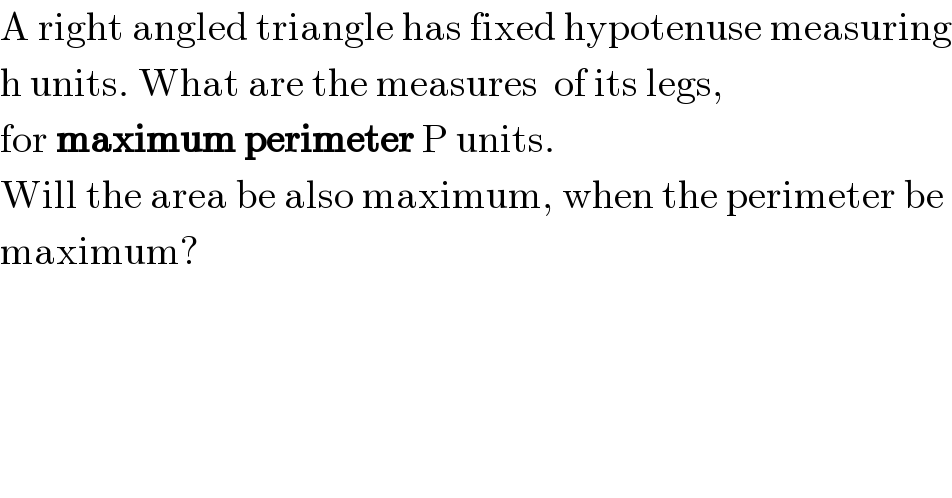
Question and Answers Forum
Question Number 1611 by Rasheed Soomro last updated on 26/Aug/15

Commented by Rasheed Soomro last updated on 28/Aug/15
![Let the measures of legs are a and b in general and A and B in case perimeter is maximum: A+B+h ≥ a+b+h ∀ a,b∈R^+ ⇒A+B ≥ a+b ⇒(A+B)^2 ≥(a+b)^2 [ ∵ A,B,a,b >0] ⇒A^2 +B^2 +2AB ≥a^2 +b^2 +2ab.......................(I) But A^2 +B^2 =a^2 +b^2 [=h^2 ]................................(II) Subtracting (II) from (I) and then dividing by 2: AB ≥ ab (1/2)AB≥(1/2)ab (((Area of right angled triangle)),((with fixed hypotenuse h units)),((having maximum perimeter)) ) ≥ (((Area of any right angled)),((triangle with)),((fixed hypotenuse h units)) ) This answers second part of the Question.](Q1642.png)
| ||
Question and Answers Forum | ||
Question Number 1611 by Rasheed Soomro last updated on 26/Aug/15 | ||
 | ||
Commented by Rasheed Soomro last updated on 28/Aug/15 | ||
![Let the measures of legs are a and b in general and A and B in case perimeter is maximum: A+B+h ≥ a+b+h ∀ a,b∈R^+ ⇒A+B ≥ a+b ⇒(A+B)^2 ≥(a+b)^2 [ ∵ A,B,a,b >0] ⇒A^2 +B^2 +2AB ≥a^2 +b^2 +2ab.......................(I) But A^2 +B^2 =a^2 +b^2 [=h^2 ]................................(II) Subtracting (II) from (I) and then dividing by 2: AB ≥ ab (1/2)AB≥(1/2)ab (((Area of right angled triangle)),((with fixed hypotenuse h units)),((having maximum perimeter)) ) ≥ (((Area of any right angled)),((triangle with)),((fixed hypotenuse h units)) ) This answers second part of the Question.](Q1642.png) | ||